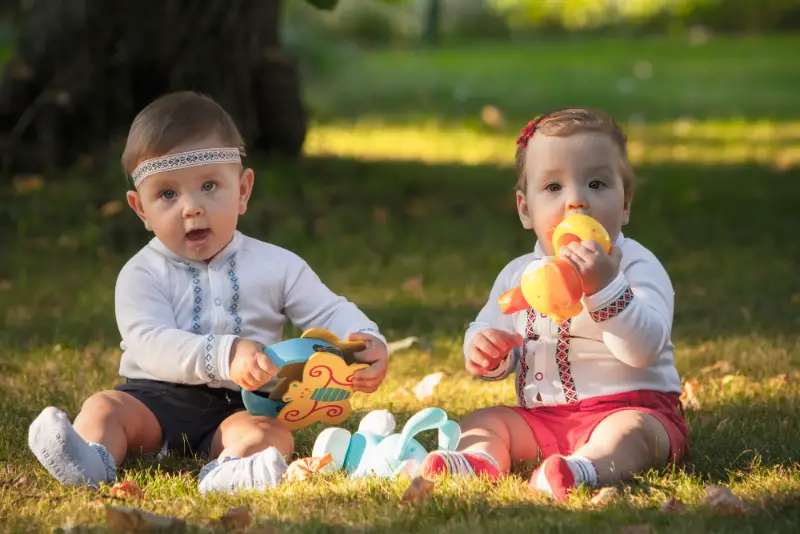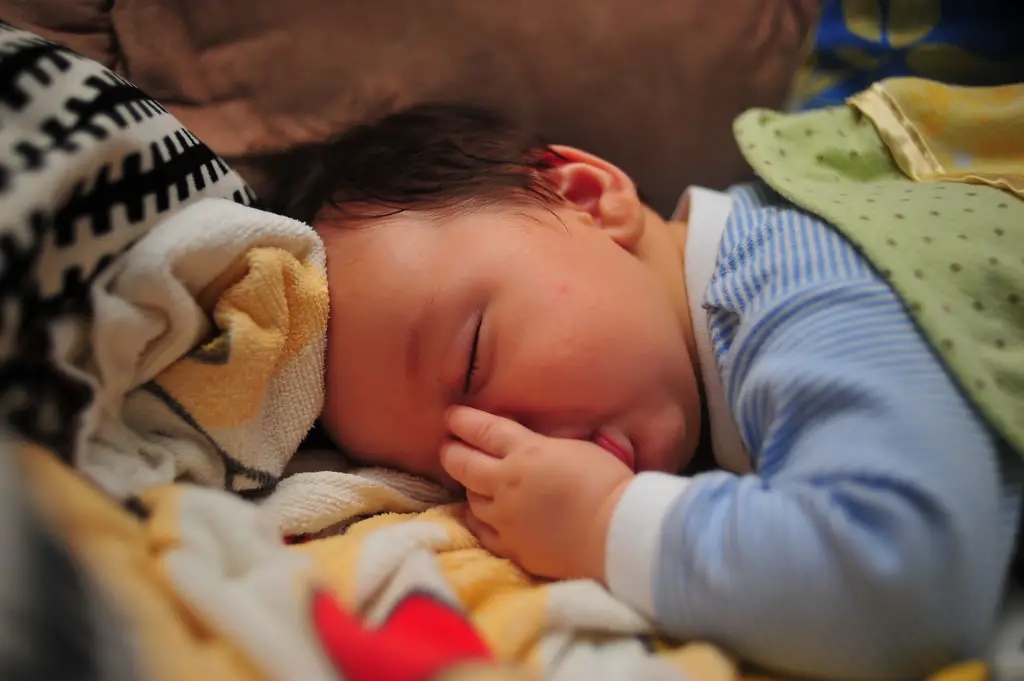Teething in Babies: What are the Signs of Baby Teething?

This article may contain links from Amazon and our partners. We may receive a small commission if you make a purchase through a link at no cost to you. Please read our disclosure policy.
Also known as odontiasis, teething refers to when a baby’s teeth break through the gums and appear. Teething can be an uncomfortable experience for both you and your young one. As a new mom, it can be confusing knowing whether your baby is just teething or unwell.
It is also essential to have accurate information about what to expect when your baby is teething and how you can make it more tolerable. If you have a newborn or expecting one, and you are wondering, “How do babies act when teething?” this article is for you.
In this post, you’ll learn about the signs of baby teething, how long teething lasts, as well as home remedies to soothe your child’s discomfort.
At What Age Do Babies Start Teething?
Teething can happen at different times for every child. It can be as early as three months or as late as one year, depending on various factors, including genetics and the nature of birth. Children born prematurely, for example, start teething much later than their counterparts.
So when does baby teething start and end? For most babies, teething usually starts anywhere between 4 and 7 months and ends at 2 or 3 years when they grow their last set of milk teeth.
Therefore, you shouldn’t worry if your child’s teeth do not appear by the time they are six months or celebrating their first birthday. If you have any concerns about your child’s teething, don’t hesitate to speak to a doctor.
Order of Tooth Appearance
Usually, baby teeth appear in pairs, and the first teeth to break through are usually the bottom incisors. To help you anticipate your baby’s teething, here’s a rough guideline on how babies’ teeth emerge.
How Long Does Teething Last?
It takes around eight days for teething to begin and end for every tooth. 4 days before the tooth emerges and four days after the tooth has broken through the gums. Once your baby starts to grow teeth, you need to adopt proper oral hygiene. It is advisable to take your baby to a dentist six months after the first tooth appears.
You should also give your baby fluoride water at about six months as part of their diet. Fluoride strengthens teeth and helps prevent tooth decay. Fortunately, tap water usually has fluoride in it. Therefore, letting your child take a few sips of the water can go a long way in strengthening and protecting their developing teeth.
What Do Baby Gums Look Like When Teething?
You can tell your baby is teething by observing your child’s gums. So how do baby gums look like when teething? As your baby’s teeth emerge, the gums become red, tender, and swollen. You may also notice slight bruising when teeth are ready to break through, as well as small white spots on the gums.
The bulge on your baby’s gums occurs due to the pressure from the tooth beneath. If you pull back your baby’s lips, you may also notice a bluish fluid buildup known as eruption cyst or teething blister. It may form on top of your baby’s gum or just beneath it and occurs due to the accumulation of fluid and blood.
Teething blisters are normal and usually go away without treatment as the teeth break through the gums and rupture them. However, if the blister doesn’t go away and impairs the growth of your baby’s teeth, you should consult a doctor.
If the fluid is so much that it prevents the teeth from emerging through the gum, your baby may need a doctor to make an incision that raptures the blister. Always ensure that your hands are clean before examining your baby’s gums to avoid exposing your child to bacteria.
Symptoms of Teething in Babies
Teething comes with several symptoms that can help you know when your baby is teething. Knowing the signs of baby teething will help you differentiate what’s normal and what is not so you can take appropriate action. Here are common signs of baby teething you should look out for.
1. Excessive Drooling
While babies usually drool as they are still learning to swallow their saliva, the drooling becomes excessive when teething. The increased drooling occurs when your baby produces excess saliva to lubricate the gums.
Sometimes, the excess drooling may cause your child to cough and also lead to rashes on your baby’s cheeks, neck, and around the mouth. You can manage the drooling by wiping it off and applying your baby’s skin with barrier cream to prevent bacteria from the saliva from causing rashes.
2. Sleeping Problems
Babies tend to sleep less and wake up earlier than usual when teething due to the discomfort and pain. If you notice that your baby suddenly has trouble sleeping, they may be cutting their first tooth. The discomfort may worsen at night due to a lack of distractions.
3. Fussiness
Teething usually comes with pain and discomfort, which causes your baby to become fussy and cry all the time. If your baby starts crying frequently, they may be teething.
4. Reduced Appetite
Babies may experience a lack of appetite when teething as they experience pain and discomfort. What’s more, feeding triggers sore areas, which makes it difficult for them to eat. Despite the resistance, you shouldn’t stop feeding your baby to maintain their calorie input and nourishment.
5. Ear Pulling and Cheek Rubbing
Teething babies pull their ears and rub their cheeks as a way of self-massage. The actions provide relief by countering the pressure and throbbing of emerging teeth.
6. Biting and Gnawing
When teething, your baby will bite and gnaw at anything they find as a means of soothing their gums. Your child biting at everything ranging from plastic toys to your nipples when breastfeeding is a sign of baby teething as they try to ease the discomfort.
While your child doesn’t have to exhibit all the above symptoms, observing more than two is a sign of baby teething.
Is fever a sign of teething? Some parents notice mild fever of below 100 degrees F when the baby is teething. While it is a common belief that fever and diarrhea are symptoms of teething, the truth is—they are not.
You should consider speaking to your doctor if your child suffers from fever, diarrhea, or rashes all over the body, as they may be signs of an underlying illness.
Home Remedies for Teething in Babies
Teething can be a distressing time for your baby. Luckily, you can make it easy for your baby using the following simple home remedies.
(i) Keep the Affected Area Cool
Applying cold things on the gums can help soothe the gums and reduce the swelling. Consider placing a cold or frozen washcloth on the gums or giving your baby frozen fruits like bananas, cucumber, applesauce, and yogurt. You can also freeze a spoon for 15 minutes and give your baby to rub their gums.
(ii) Massage
Gum massage is an excellent way to relieve the pressure and discomfort of teething. Ensure you wash your hands first before massaging your baby’s gums in circular motions. You can also offer them your finger or knuckle to gnaw.
(iii) Teething Toys
Teething toys made of rubber are great for your baby to chew. When choosing teething toys for your baby, avoid those with small parts that your baby can choke on.
(iv) Chamomile Tea
Chamomile tea is known for its anti-inflammation properties. You can massage the baby’s gums with tea for a soothing effect. Ensure you use chamomile tea without caffeine as a baby’s nervous system can’t handle it.
(v) Teething Biscuits
Teething biscuits are appropriate for babies above eight months. Ensure that you clean your baby’s mouth after giving them the biscuits to prevent plaque formation. You can decide to wipe the gums or use a toothbrush to clean your baby’s mouth.
Final Thoughts about Teething in Babies
If your baby is in immense pain, you can give them age-appropriate pain medications, such as children’s Motrin or Advil. Avoid treatments with benzocaine as they can lead to a rare illness known as methemoglobinemia.
The condition reduces the amount of oxygen in the blood. Other teething remedies to stay away from including teething necklaces and rings as they can easily break off and become choking hazards. Lastly, topical gels also wash away fast due to the baby’s excessive drooling, making them highly ineffective.
With the above information about teething, you will be well equipped to take care of and support your baby as they grow their milk teeth.
Sources: Healthy Children, Baby’s First Tooth: 7 Facts Parents Should Know, Nov 2020, Children’s Hospital Los Angeles, Your Infant is Teething: Know the Signs and Symptoms, Jul 2020, Kids Health, Teething Tots, Jan 2018, Cleveland Clinic, Teething 101: 4 Pediatrician-Approved Ways to Soothe a Teething Baby, Aug 2018 and PubMed, Symptoms Associated With Infant Teething: A Prospective Study, Apr 2000.





